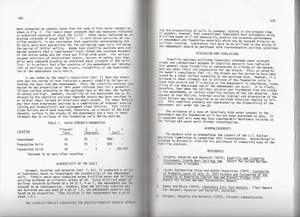were conducted on samples taken from the zone of high water content as shown on Fig. 2. The lowest shear strength that was measured indicated an undrained strength of about 300 lb/ft2. Other tests indicated an undrained strength of about 900 lb/ft2. In this third variation of stability analysis, it was considered that conditions represented by the UU tests were more appropriate for the collapsing type soils following the period of initial wetting. Wedge type stability analyses were conducted assuming that a longitudinal crack formed the upstream boundary of the active wedge and the crack was filled with water. For various assumed positions of longitudinal cracks, factors of safety less than unity were computed assuming an undrained shear strength of 300 lb/ft2. Thus, it is evident that after cracking of the embankment and introduction of tailings water into the cracks, instability of the downstream toe of the embankment could result.
It was noted by the owner's consultants (Ref. 2) that the breach area was too narrow to have indicated a general stability failure extending far back into the embankment. Also, the stability analyses conducted in the preparation of this paper indicate that for a potential failure surface extending to the upstream face of the dam, the factors of safety are high. However, instability of the downstream toe as indicated by the stability analyses reported herein may have resulted in an initial shear failure of relatively small extent. The shear failure may then have progressed upstream by a combination of internal erosion (piping and dispersivity) and subsequent slope failures. This initial slope failure would have occurred, therefore, as a result of the high phreatic surface in the cracks of the embankment and a loss in shear strength due to collapse of the foundation soils during wetting.
| Triaxial | ¯ɸ | ɸ | ¯c | c | |
| Location | Test | (Degrees) | (psf) | ||
| Embankment | CU | 25 | - | 5001 | - |
| Foundation Soils | CU | 19 | - | 200 | - |
| Foundation Soils | UU | - | 0 | - | 300-900 |
| 1Assumed to be zero after cracking. | |||||
Sergent, Hauskins and Beckwith (Ref. 1, Vol. 3) conducted a series of laboratory tests to investigate the dispersivity of the embankment soils. Pinhole tests were conducted using distilled water and tailings solution buffered to different values of pH. Using distilled water or tailings solution buffered to a pH of 2, 4 or 7, the embankment was Indicated to be nondispersive. However, when the tailings solution was not buffered and was used at a pH of 1.2, the embankment material was found to be dispersive. (The solution in the impoundment has a pH of about 1.2.)
The state-of-the-art concerning the physico-chemical aspects affecting the dispersivity of soils is somewhat lacking at the present time. It appears, however, that conventional laboratory test procedures using distilled water will not necessarily predict the accurate performance of embankment and foundation materials which may be exposed directly to tailings solution. Laboratory test data to be utilized in the design of the embankment should be performed with representative tailings solutions.
Stability analyses utilizing laboratory obtained shear strength values and conventional methods of stability analysis have indicated that general slope instability as represented by sliding of the embankment was most likely not responsible for the breach. Also, as noted by the owner's consultants (Ref. 2), the breach was too narrow to have been caused by a shear failure extending to the upstream face. However, if a decrease in shear strength due to collapse of the foundation soils is taken into account and if cracking of the embankment is considered, instability of the downstream toe of the embankment can occur. It is likely, therefore, that when the tailings solution was introduced into the cracks in the embankment, an initial stability failure of the toe occurred. Subsequent to that failure, internal erosion (piping) and progression of the slope failure may have occurred in an upstream direction leading to failure. This condition probably was aggravated by the dispersivity of the embankment soil under the low pH.
The existence of a zone of relatively high water content in the embankment and the foundation soils has not been explained to date. It is expected that this zone may have considerable importance relating to the failure and would merit further investigation.
The authors wish to acknowledge the support of the U.S. Nuclear Regulatory Commission in conducting this investigation. Appreciation is extended to Richard G. Crim for his assistance in conducting many of the stability analyses.
1. Sergent, Hauskins and Beckwith (1979), Stability and Integrity Assessment, Church Rock Tailings Dam. Report for United Nuclear Corporation, 4 Volumes.
2. Jacobs Engineering Group and Wahler Associates (1979), Evaluation of Probable Cause of July 16, 1979 Failure and Evaluation of the Integrity of Remaining Starter Dam and Present Divider Dike. Report for United Nuclear Corporation, August.
3. Dames and Moore (1979), Laboratory Soil Test Results. Final Report for Sergent, Hauskins and Beckwith, September.
4. Sergent, Hauskins and Beckwith (1979), Personal Communication.
